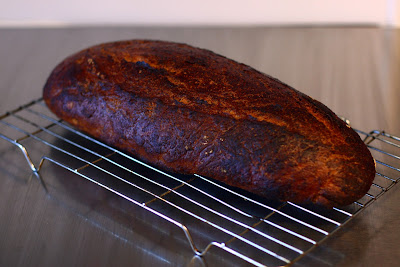June 2, 2011
Baked this loaf as something of a thank you to some people that could not be any more welcoming, generous, and kind. Brilliant, in a word. Hopefully this bread is to their liking.
[350W - 150RY - 150ST - 350WA] autolyse 25 minutes (2230-2300)
[50WA - 11SA] mix, bulk ferment 2 hours, fold every 30 minutes (2300-2330-0000-0030-0100)
shaped into a round and bench rested for 20 minutes, then shaped and set in a tin to retard (0130)
Dough typically pasty for rye on first mixing, after autolyse, salt, and more water the dough had a much better consistency that held together (no doubt due to the heavy amount of strongwhite flour involved). This time around I tried baking with the starter itself because I did not have time to prepare a young leaven (hence the "ST" instead of the usual "LE"). Note: Starter was very watery since it had been 14 hours since last (larger than usual 100:100) feeding, but did, for the most part, pass the float test (the main portion of it floated while some little strands broke off and sank after hitting the water).
At first folding it seemed quite soggy and droopy, but the dough did congeal and stretch as the gluten from the white flour developed. By second folding it resembled my typical country dough other than coming apart slightly easier. It did tense up quite a bit by the time it was bench rested, and did not exhibit much droop over 25 minutes though it remained very sticky and wet. Roughly attempted to shape it, folded it in threes a few times but wasn't able to roll it very effectively. Slightly worried the dough did not expand enough during fermentation. Even after retarding for 5.5 hours the dough did not fill out enough to cover the entire bottom of the loaf tin. Forgot to spray the loaf with water before baking, but slashed lengthwise and put into a steamed oven (@0715). Baked for 1:15, crust came out dark brown with steam breaking through the surface in a few places.
This bread had a chance to cool for a while before it was broken open. Instead of the usual crackling of the crust, the loaf hissed with steam for at least 10 minutes after it was taken out. After sitting for nearly two hours, we finally cracked it open for a taste. The crust was pretty crispy and had a strong rye flavor and an interesting speckled texture and mouthfeel that I would attribute to the coarseness of the rye flour. The crumb was super moist and reminiscent of most of my recent country loaves, exhibiting a lot of spring and not too - airy, but well distributed in structure.
This bread had a chance to cool for a while before it was broken open. Instead of the usual crackling of the crust, the loaf hissed with steam for at least 10 minutes after it was taken out. After sitting for nearly two hours, we finally cracked it open for a taste. The crust was pretty crispy and had a strong rye flavor and an interesting speckled texture and mouthfeel that I would attribute to the coarseness of the rye flour. The crumb was super moist and reminiscent of most of my recent country loaves, exhibiting a lot of spring and not too - airy, but well distributed in structure.














0 comments:
Post a Comment